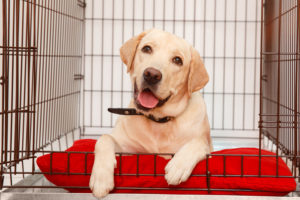You’ll find all sorts of pros and cons to crate training on the internet. You’ll also find all sorts of tips and tricks for crate training your puppy. As I write this, I’m crate training (and training in general) my Boxer puppy, Gretel (she’s the Boxer pup on the front page of fallsvetclinic.com). My former dog, Bridget, was an absolute all-star. But as a puppy, she was a pain in the hind end to crate train:

lots of barking and whining overnight for 2 to 3 weeks, urinating in her crate on a regular basis, lots of necessary baths because of the regular urinating… it was tough. But I stuck with it and I couldn’t have been more thankful!
Why crate train? Crate training builds security, prevents damage in the home, accelerates the potty-training learning curve and gets them ready for a time when they’ll need to be confined crate (travel, hospitalization, boarding, etc.)
The crate you choose needs to be just big enough for the dog to stand and turn around comfortably. Plan ahead. Some puppies grow very big!
Most puppies don’t naturally love their cage, but with time and consistency, your puppy will come to know the crate as a safe, calm place. How? Here is my philosophy behind crate training and what I’ve done to crate train my dogs:
- Have a routine and be consistent. My young dogs sleep in their crate every night. They’ve come to understand this as the normal thing to do. They don’t know another way of life. They don’t sit in their crates wondering if their litter mates are sleeping in a Sleep Number Bed somewhere. Gretel always goes outside to do her business right before and right after her crate time.
- Do not reward bad behavior. I mentioned that Bridget whined and barked a lot as a new puppy in her crate. (<–understatement) Going to her and telling her that it was “alright,” or letting her out of her crate in the middle of this behavior would have set the crate training back many months. She needed to learn that she was expected to be calm when she was in her crate. Do not acknowledge anything other than acceptable behavior.
- Start by making the crate a positive place. Feeding your puppy in the crate or giving a treat such as a biscuit or a stuffed Kong toy can show that good things can happen in the crate.
- Never force your dog to leave the crate. Dogs need to understand that their crate is a safe place for them. Some dogs will run to their crate when they know they’re in trouble. As much as you’d like to discipline/punish them, it’s okay that they’ve gone to their crate because this shows that they know that the crate is their place. It needs to be their own little section of the house.
- Don’t use the cage simply for punishment. I also don’t use the cage as a “time out” immediately after they’ve done something bad. But…
- I do use the crate to protect my dog and prevent her from doing something bad. (This stems from my #1 rule of puppy training: Don’t give a dog an opportunity to make a bad decision.) When I’m at work, and my wife is showering and getting ready for the day and keeping watch over our 2 year old son at the same time, it would not be wise to allow Gretel to roam the house and do something such as poop in the dining room or chew on the couch. Why give her an opportunity to be bad? My wife can then release her from her crate when the morning chores are done and everyone’s happy!
“But when can I leave my dog out of the crate when I leave the house?” is a common question I hear. Or another is, “When can I let them sleep outside the crate at night?”
My initial answer is, “Whenever you’d like.” But if you want to know that your dog is being good, and that you won’t come home to a wet floor, a chewed-up pillow, blinds that aren’t hanging anymore, or wake up to find the contents of your garbage can spread all over the floor, having your dog sleep in the crate will make sure that everyone has positive vocal tones and body language when you arrive home or wake up.
And besides, why send your dog mixed signals? With proper crate training, your dog understands that time in the crate is a normal part life. If you take an “in again, out again” approach to the crate, that’s a sure way that your dog will not learn that the crate is a good, safe place.
If you have additional questions or thoughts about crate training that you’d like to share with us, feel free! We welcome the opportunity to strengthen the bond between you and your dog.
Remember, the goal of crate-training is aid in the socialization and training of your puppy.


The Cuyahoga Falls Veterinary Clinic | Animal Wellness | Medical Services | Pet Services
[…] *really* expensive foods out there. How much are routine shots for your puppy? Do you really need a crate? How many veterinary visits will you need? Wow. Wouldn’t it have been nice if there were some […]